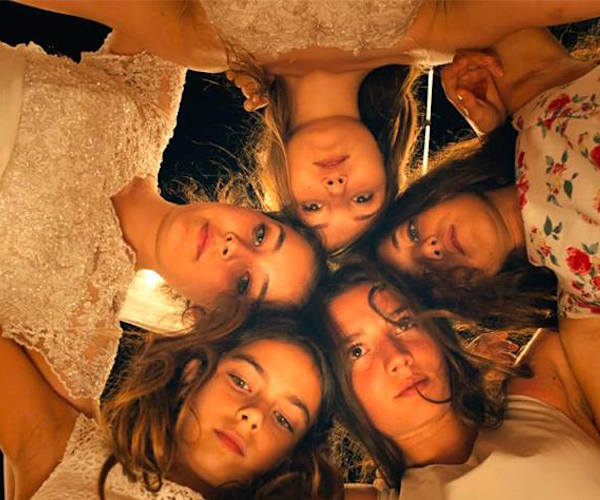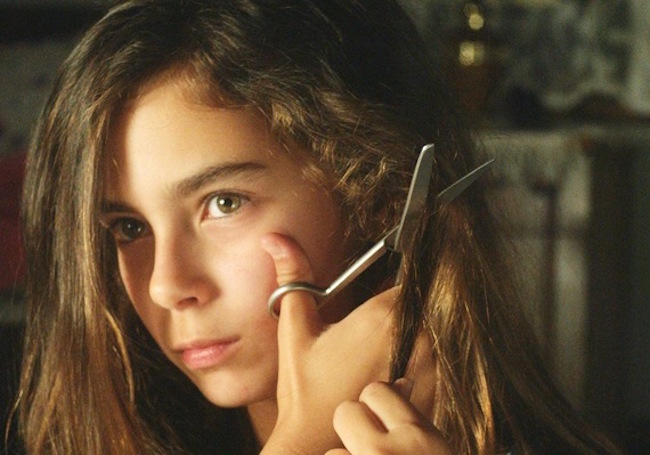Film Review: “Mustang” — Passion, Caged
Despite being entrapped in a controlling social order, the sisters behave as most adolescents do: sometimes impulsively, sometimes calculatingly, but almost always merely reacting to what is happening around them, or inside them.
Mustang, directed by Deniz Gamze Ergüven.

A scene from the film “Mustang.”
By Peg Aloi
One doesn’t often think of coming of age films aimed at the arthouse crowd as suspenseful or horrifying (unless they’re also horror films), though some examples come to mind: The River’s Edge, perhaps, or maybe Dogtooth, or Peppermint Soda, or perhaps A Ma Soeur!/Fat Girl, or Ripe…okay, yeah there’s a lot of them. Then there’s The Virgin Suicides, Sofia Coppola’s dreamy adaptation of a story by Jeffrey Eugenides, about five sisters who live in suburban Michigan in the 1970s, whose parents decide to imprison them in the house after the youngest commits suicide.
The Turkish film Mustang, a feature debut from director Deniz Gamze Ergüven, has been drawing comparisons to Coppola’s film, because that central conceit, of five teenage girls imprisoned in their home, repeats here. Narrated by a laconic Giovanni Ribisi, looking back in time on his teenage years as one of the neighborhood boys who befriended the sisters, The Virgin Suicides shows us the girls’ plight from the outside, through the eyes of others. But Mustang’s narrator is the youngest sister, the energetic and defiant Lale (Güneş Şensoy), who appears to be 11 or 12. She loves school, and as the film opens on the last day of the term before summer, Lale tearfully hugs her teacher who is moving to Istanbul.
Lale’s oldest sister Sonay (who’s about 17) suggests they walk home, as it is hot and sunny. They stop by the beach and engage in a rowdy game of chicken in the water, fully clothed in their school uniforms, perched on the shoulders of male schoolmates. They arrive home and their grandmother, their legal guardian along with their uncle after their parents’ death a decade earlier, is outraged by some gossip she heard — that the girls were behaving lewdly with the boys. They all deny any wrongdoing. When Lale sees the neighbor on the street who ratted them out, a conservative Muslim woman in a brown dress and hijab, she screams at her and her “shit-colored dress.”
Things worsen when their uncle Erol returns home. Even as their grandmother backs down from her initial anger, Erol is livid and decides the girls have been raised too liberally. The two oldest are taken to a doctor for “virginity reports” to determine their fitness to marry. Anything that might corrupt them is locked up: cosmetics, phones, colorful clothing. The grandmother makes them traditional garments to wear: “Now we are all wearing shit-colored dresses,” Lale observes. This is another parallel to The Virgin Suicides, where the sisters were forced to dress in frumpy, old-fashioned dresses, had their LPs taken away, and were not allowed to socialize with anyone. The parallel of girls in the 1970s, growing up amid volatile social change including the sexual revolution, aligns well with these five sisters in contemporary Turkey. Their conservative guardians are clinging to traditions that view the girls as chattel who would become outcasts if their purity was compromised.
Similarities aside, the difference in attitude among the imprisoned sisters is notewothy. In Coppola’s film, the girls all seem to be resigned, languid, and bored, unwilling to challenge their parents who, like them, are grieving; they seem to accept their fate. Then there’s Lux (Kirsten Dunst), who finds a way to sneak out and explore her burgeoning sexuality, becoming increasingly self-destructive. The sisters in Ergüven’s film are restless and indignant — upset because they did nothing to deserve their incarceration. When Lale’s friend tells her that a bus is taking her schoolmates to a football match, she contrives to bring her sisters along, and the girls sneak out, dressed in jeans and sneakers, to enjoy a night of freedom. When their aunt sees them on TV, she shuts down the electricity, first in the house and then in the town, to prevent Erol from seeing the girls’ disobedience.

A scene from “Mustang.”
But things change for the worse anyway. The feisty Lale watches in horror as her grandmother orders iron gates erected to keep intruders out, and maneuvers to get all of her sisters married off as soon as possible. Lale does her best to sabotage things when she can. “The house turned into a wife factory,” she says, and it appears that daily there are older woman, relatives and friends, visiting to demonstrate cooking and sewing techniques. Sonay is able to marry the boy she has been sneaking outside to see (climbing down the vine-covered drainpipe, in a sort of reverse-Rapunzel image); but the next oldest, Selma, is forced into an arranged marriage with a stranger; the two sisters marry on the same day. The three remaining sisters settle into a routine without the others; Lale sneaks out for walks and befriends a delivery boy who teaches her how to drive.
When plans emerge for middle sister Ece to marry, Lale senses things are becoming desperate and that her time will come soon enough. Nur, only slightly older than Lale, is also to be groomed for marriage and her face freezes in disbelief: “Are you kidding me?” For Lale, it has gone beyond losing her autonomy, her innocence or even her sisters; she now feels her very life is at stake, and worries when Nur seems too compliant. The last quarter of the film is given over to the girls’ inspired and harrowing efforts to escape.
The film is never self-consciously stylized or manipulative; even the hauntingly lovely score by Warren Ellis (a frequent collaborator with Nick Cave) does not overburden the action. This story feels plausible and intimate. Despite being entrapped in a controlling social order, the sisters behave as most adolescents do: sometimes impulsively, sometimes calculatingly, but almost always merely reacting to what is happening around them, or inside them. Today’s culture seems crowded with teenage heroines beset with problems related to too much freedom of choice, not too little. The resourceful Lale, who breaks free from tyranny using her wit and passion, is the type of firebrand we need to see more of.
Peg Aloi is a former film critic for The Boston Phoenix. She has taught film studies for a number of years at Emerson College and is currently teaching media studies at SUNY New Paltz. Her reviews have appeared in Art New England and Cinefantastique Online, and she writes a media blog for Patheos.com called The Witching Hour.
